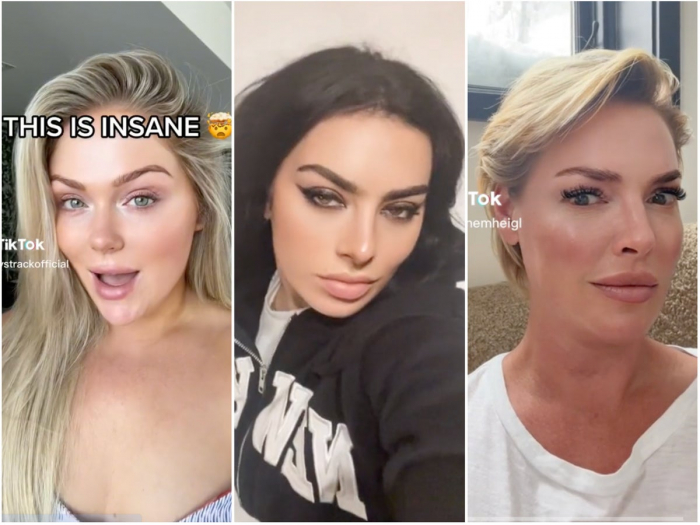Beauty filters like TikTok's new Bold Glamour can transform people's appearance, and the technology is now strikingly seamless. What can research tell us about the psychological consequences?
When I came across my first "beauty filter" – technology designed to "improve" your appearance, now popular on Instagram, Snapchat and TikTok – one of my first reactions was that it evened out the playing field and not, necessarily, in a bad way.
Before the pandemic, I usually put on some make-up before going out. It made me feel more attractive – and the different way people treated me when I put on a bit of mascara only bolstered that perception. But then came lockdown, working from home, and having a baby. Finding the time and motivation to apply lipstick felt like a thing of the past. And so, when I first saw a filter that did the work for me – or for my online presence, at least – I was amazed. And I had to wonder: was there really that much of a difference between spending 15 minutes applying make-up in the morning, and slapping a filter on my online persona? Or was the latter just an ingenious way to save time?
As beauty filters become more and more sophisticated, articles decrying their potential effect on everything from our self-esteem, to their power in popularising one particular beauty standard, are becoming more frequent. This week, the release of TikTok's "Bold Glamour" filter – which has a strikingly seamless effect – prompted many users to question if the technology has gone too far. It can turn anyone into an airbrushed top model. As one headline reads: "'This is a problem': A new hyper-realistic TikTok beauty filter is freaking people out".
These concerns and criticisms are valid, but often overlook a crucial component. Like so much else in technology, beauty filters weren't created in a bubble, separate from society, to then infect the rest of us. They reflect – and often worsen – the biases and issues we already have. Which is, of course, the problem.
Long before the Bold Glamour filter came along, our society fetishised beauty. And it isn't just about physical attraction: conventionally good-looking people are seen as everything from being more intelligent to earning a higher income. (Although for women, in some situations, beauty can backfire.)
The truth is that, whether with our choice of clothing or haircut, glasses or makeup, we all represent ourselves in a certain way – and, usually, in a way that is in accordance with current beauty standards. While we like to think that we make these choices based on our individual preferences, we've long known that those preferences are shaped by current styles. While there's plenty of research to prove this, you can also just look at the appearance of the people around you: even a feature as seemingly unchangeable as eyebrows has morphed from the skinny eyebrows of the 1990s to the super-bold in the 2010s (and it's already changing again).
Of course, there's a difference between following real-life beauty trends and applying online filters. Cosmetics can create the illusion of more chiselled cheekbones; a beauty filter actually (virtually) chisels them. But in an era in which minimally invasive, highly effective cosmetic procedures like Botox are becoming more and more popular, too, it's safe to say that more of the people you see in real life have had a bit more "help" than you might expect. As our real-world ability to shave years off and recreate beauty standards in our own lives has risen exponentially, it naturally follows that we're seeing the same phenomenon online.
That doesn't make it any less problematic. In fact, it can be a vicious cycle: beauty filters aren't just responding to existing beauty standards – offline beauty standards are changing in response to filters. Adolescent girls who use filters are more likely to consider cosmetic surgery, for example, and plastic surgeons have noted a rise in clients requesting surgery that makes them look more like their filters. This is even more concerning given that these filters tend to be racially biased, based on stereotypically "white" characteristics.
And these are just facial filters. There are plenty of ways that you can now tweak your body in social media apps, even in video, too. Again, in some ways, this is nothing new. Professional models and photographers long have known that specific poses and angles can elongate legs and tighten waists – and gone on to tweak images in post-editing with software. Today's social media influencers often rely on these strategies, too, as exposed by advocates like Dana Mercer Ricci. By making it so that anyone can nip their waist or plump their lips in an online video or photo, you could argue that these filters are just making industry tricks more accessible. While some may welcome the wider availability of the technology, it's also the case that these filters are too new for us to know exactly how they affect self-perception and mental health long-term.
The research done so far indicates that they could make users feel worse about themselves. Part of that is from seeing so many images of other people that are heavily filtered and perfect. Even before the rise of beauty filters, people who spent time on social media sites focusing on others' idealised lives were likely to have poorer psychological well-being. But it's also true even when looking at a filter applied to our own image.
Adolescent girls, who are especially vulnerable to internalising images they see in the media, are especially at risk. One study, for example, found that when girls aged 14-to-18 years old were shown either original selfies or those that had been retouched, they thought the retouched photos looked better – and those who had been shown retouched photos were less satisfied with their bodies afterwards than those who had not.
While TikTok's Bold Glamour is getting most of the press, there are other filters that are problematic in a different way. One of the most disturbing is the TikTok filter "Teen", which makes anyone look like an adolescent. Child safety experts have expressed concerns about this latest, most high-tech instalment of our obsession with youth. It can be used by adults in sexually enticing poses or clothing, for example, leading viewers to think the person posing is a teen. It once again highlights – and also augments – a dangerous aspect of society: in this case, the normalisation of the sexualisation of children.
Beauty filters may just be another step along the path of our cultural obsession with perfecting our appearance. But if the response so far is anything to judge by, they could be a step too far.
More about:
















































